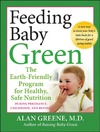The new ''baby feeding bible'' from the award-wining author of Raising Baby Green
Called the ''Al Gore of Parenting'' by Parenting Magazine, Dr. Alan Greene has written the follow up to his best-selling book and offers parents a definitive guide for making nutritionally-sound decisions for their children. Offers parents green choices for feeding children from when they are in the womb through toddler years.
This unique guide includes advice on how to transform a baby's eating habits that will positively impact their health and development for the rest of their lives. Dr. Greene has included everything a parent needs to know about creating healthy, nutritious meals that help avoid childhood obesity, and prevent childhood disease. This must-have resource
- Shows how what a mother eats during pregnancy effects her baby's health and eating habits for years after birth
- Provides the definitive guide to ''green'' feeding for babies from pregnancy to toddlers
- Filled with practical tips and advice for selecting and preparing earth friendly meals for babies
- Shows the health benefits for babies who eat ''green'' with innate nutritional intelligence
- The crucial follow-up to the best-selling book Raising Baby Green
In addition to working in his medical practice, Dr. Alan Greene makes regular appearances on the Today show and writes articles for the New York Times.
It’s Time for a Delicious Revolution
By Dr. Alan Greene
Konrad Lorenz made his mark by studying a special type of learning where key exposures during a critical and sensitive window of development can have a lasting influence – a process he called imprinting. The famous example of this is imprinting in geese. Newly hatched goslings are programmed to follow the first moving objects they see. They quickly become imprinted on this object and will move their little feet fast to keep up with it. This is highly adaptive. Most of the time. Usually this moving magnet is the gosling’s mother.
![]() |
| Photo by Howard Schoenberger |
Lorenz showed, however, that if he were the first mover that a gosling saw, it would be imprinted on Lorenz and follow him about, refusing to follow a goose. A goose could even imprint on a toy train and ignore other geese, even its own mother. Later, as adults, these geese would even choose toy trains for their life partners (which didn't work out well for the geese — or the trains). Lorenz won the Nobel Prize for this work in 1973.
We’ve known for at least thirty years from animal studies that very early flavor experiences change which foods will later be preferred. Within five years of Lorenz’s Nobel Prize, food imprinting had already been demonstrated in snapping turtles, chickens, gulls, dogs, and cats.
Human babies also learn by imprinting, though ours is more complex, more forgiving, and occurs during a longer critical window. In particular human babies imprint on food. This is a highly adaptive mechanism — but in the second half of the twentieth century we have unwittingly imprinted our children on the wrong tastes and textures. They will chase after junk food and kids meals, and ignore a delicious, ripe peach or tomato packed with nutrients their bodies crave.
Feeding Baby Green unveils the key windows of opportunities for our children, and how the imprinting occurs using not just taste but all of the senses, from pregnancy through age 2 (and beyond — with a final chapter giving an overview up to age 9).
At its core, Feeding Baby Green is a revolutionary approach to cultivating Nutritional Intelligence, the age-appropriate ability to recognize and enjoy healthy amounts of great food. Pregnancy and the first two years of life are critical windows for learning Nutritional Intelligence, an important, newly described strand of development. Most American kids of the last few decades are Nutritionally Delayed. Thankfully, this is easy to remedy.
 |
|
О проекте
|
|
О проекте


